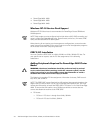
1-4 Dell PowerEdge Cluster SE100, SE200, and SL200 Platform Guide
!"#$'%
'%&
$%&'
()"
*
#
The following list provides PCI slot assignment information for buses, RAID control-
lers, NICs, and a DRAC 2.
PCI buses
— PCI bus 1: PCI slots 1 through 3 are 32-bit, 33-megahertz (MHz)
— PCI bus 2: PCI slots 4 through 7 are 64-bit, 33-MHz
RAID controllers
— RAID controllers can be installed in any available PCI slot
— If you use multiple RAID controllers and there are slots available, Dell recom-
mends installing the RAID controllers on separate PCI buses to balance the
load on the system
NICs
— You can install NICs in any available PCI slot
DRAC 2
— If you are currently using a DRAC 2 or plan to use one in the future, install it
in PCI slot 3
NOTE: To make sure that the SCSI or RAID controller attached to the boot drives
initializes first, you may have to change the scan order of the PCI bus, if the BIOS sup-
ports this option, or change the order of the RAID controllers, NIC(s), and DRAC 2.
Performing these tasks ensures that Windows numbers the boot drives in the proper
sequence.
PowerEdge Clusters SE200 and SL200 support clustering with Windows NT
Server 4.0, Enterprise Edition or Windows 2000 Advanced Server. See the following
sections for information on supported configurations and SPs for your Windows oper-
ating system.


















